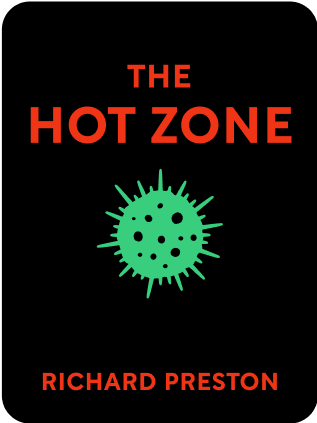

This article is an excerpt from the Shortform summary of "The Hot Zone" by Richard Preston. Shortform has the world's best summaries of books you should be reading.
Like this article? Sign up for a free trial here .
What is Ebola Reston? How does it compare to other Ebola viruses?
Ebola Reston is a strain of Ebola virus in the Filovirus family. There were several outbreaks of Reson Ebolavirus in the United States.
Read more about Ebola Reston and the outbreaks of the disease.
A New Filovirus: Ebola Reston
While Jerry Jaax’s team worked through the monkey house, an Army scientist managed to create a rapid test to detect Ebola virus in blood and tissue, called a rapid Elisa test. But when he tested samples from Frantig—the monkey caretaker who vomited and had the high fever—they came up clean.
Frantig was recovering in the hospital and feeling much better. It seemed now that he simply had the flu, so the CDC allowed him to return home.
When Frantig and Purdy—the monkey house worker who’d had a heart attack—each got sick without having had any cuts or blood exposure, it terrified the Army and CDC because it indicated that the virus had gone airborne. However, now both Frantig and Purdy appeared to be fine.
Meanwhile, Jahrling continued testing his and Geisbert’s blood for the virus, and they still tested negative for Ebola. It had been nearly three weeks since they’d sniffed the vial with the virus, and neither had shown any symptoms.
Either Jahrling, Geisbert, and the monkey house workers had dodged infection, or they were dealing with a new filovirus.
Ebola Reston Looks Like Ebola Zaire But Acts Differently
As the CDC tried to track down the origin of the Reston Ebola outbreak, their investigation led back to the monkey storage facility in the Philippines that had sent Hazleton the shipment of monkeys. CDC researchers discovered that monkeys in that facility had also been dying, but the monkey workers were all fine.
This virus—which was later named Reston—appeared to be so similar to Ebola Zaire that it was hard to distinguish them in microscopic images. But two things were significantly different about Ebola Reston:
- The way the virus traveled through the monkey house—infecting monkeys in separate rooms with no direct exposure—suggested it was airborne.
- Unlike the other filoviruses, it didn’t appear to affect people.
Researchers and officials at USAMRIID and CDC were stuck on several critical questions about the Reson Ebola outbreak:
- If Ebola Zaire and Ebola Reston were so similar, why wasn’t Reston ebolavirus harmful to humans?
- Ebola Reston traced back to the Philippines, but how could it be so similar to Ebola Zaire if it originated on a different continent?
With still so much unknown about Reston Ebolavirus it remained classified as a Level 4 hot agent, despite the fact that it had yet to make any humans sick.
1990: Another Outbreak Hits Reston
After the Army was confident that the Reston facility was sterilized, it returned the monkey house to Hazleton’s custody. Hazleton resumed importing monkeys from the same supplier in the Philippines, and, within a month, the Reston facility had another outbreak.
As a result, the CDC imposed serious restrictions on companies that imported monkeys to mandate stricter testing and quarantine practices. The CDC also temporarily revoked Hazleton’s license for quarantine violations—though officials still praised Hazleton for making the responsible decision to turn over the Reston facility to the Army during the first outbreak.
Because Ebola Reston didn’t appear to harm humans, the Army, CDC, and Hazleton agreed to isolate the monkeys inside the facility and let the virus work through them, instead of bringing the Army back in for another round of sterilization during the Reston Ebola outbreak.
The virus traveled to every room, eventually killing the entire monkey population. Infected monkeys had flu-like symptoms, including:
- Runny noses of mucus mixed with blood that wouldn’t coagulate
- Pneumonia, with rotten lungs that were heavily laden with the virus
- Red eyes
Based on how the virus was moving through the monkey house and affecting the monkeys, the virus seemed to have mutated since the month prior, indicating it could quickly adapt to new hosts and survive significant changes in its environment.
All Four Reston Workers Contract the Virus
As Ebola Reston ran through the facility, one of Hazleton’s animal caretakers—referred to as John Coleus—cut his thumb as he was performing a necropsy on one of the monkeys. The blade was covered in blood from the monkey’s liver, where Ebola virus particles tend to concentrate. There was no question he’d be infected.
However, Coleus appeared to be fine. Another health issue forced him to have a minor surgery shortly after he’d been exposed, but, unlike typical Ebola patients, his blood coagulated normally.
All four caretakers from the Reston facility—Coleus, Purdy, Frantig, and another worker—ultimately tested positive for Reston Ebolavirus But none of them ever broke with symptoms. Of the four, only Coleus was exposed through a cut, meaning Purdy and Frantig must have contracted the virus through the air, worsening the Reston Ebola outbreak.
USAMRIID Deems Ebola Reston Airborne
When USAMRIID researchers viewed samples of infected monkeys’ lungs, they saw that the virus had gotten into the lungs, taken over the cells, and multiplied until the cells were bursting with virus particles. The virus was present in the lungs’ air spaces, so when the infected monkey coughed, the virus shot out with the sputum. The same would be true in infected humans.
Although the virus was harmless to people at that point, researchers worried that it could easily mutate to become just as deadly to people as the other filoviruses—and its airborne transmission would make the effects far deadlier.
On one hand, the close contact required for transmission and the successful containment at Hazleton relieved some fear of a major epidemic or pandemic. On the other hand, all the questions that still remained about the filoviruses—including their hosts, where they originate, and how and why they emerge—amplified the fear of future outbreaks.
(Shortform note: Since the book’s publication in 1995, there have been Ebola outbreaks every few years, the majority of which have been Ebola Zaire. Most have been fairly small (less than 100 cases) and centered in Western Africa, but one was a far outlier: From 2013-2016, Ebola Zaire spread across 10 countries, infecting more than 28,000 people and killing more than 11,000.)

———End of Preview———
Like what you just read? Read the rest of the world's best summary of Richard Preston's "The Hot Zone" at Shortform .
Here's what you'll find in our full The Hot Zone summary :
- The many different strains of Ebola, including the deadliest kind with a kill rate of 90%
- How scientists unraveled the mystery of a new strain of Ebola
- How Ebola could become airborne, becoming one of the deadliest viruses known






